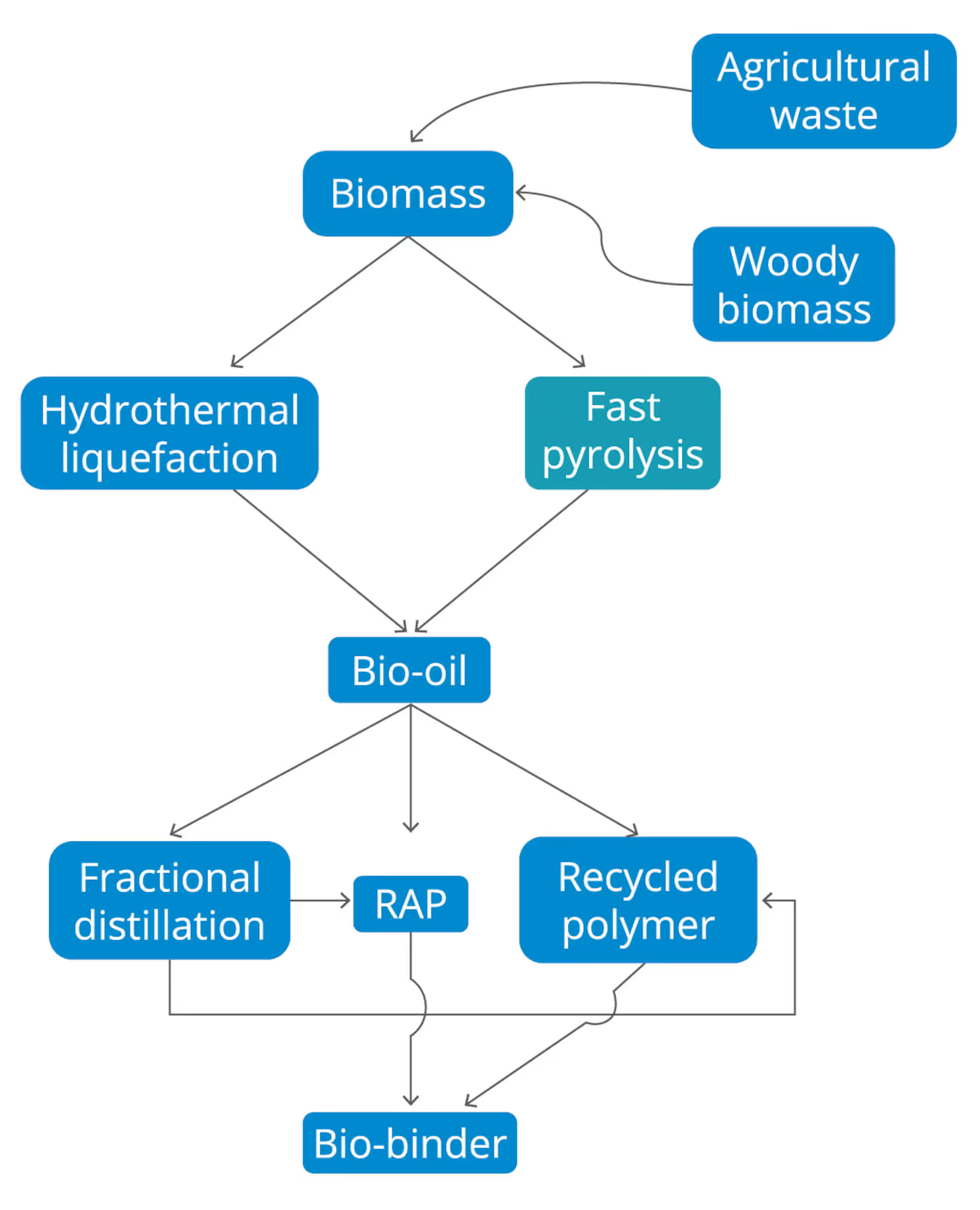

Addressing the impact of human activity on the environment has been increasingly at the forefront of academic and industry research activities. Although many industries are developing means to tackle this, few have the capacity to affect it at such a scale as infrastructure.
As non-renewable fossil fuel deposits start depleting, a relative increase in the price of bitumen will be noticed (Austroads, 2012). For countries like Australia, which have extensive road networks requiring yearly maintenance, this may significantly impact infrastructure quality and development. The annual requirement for bitumen in Australia exceeds 800,000 metric tonnes (Asphalt Institute, 2022). This short research update introduces one of the R&D projects NTRO is undertaking aiming to investigate the development of bio-binders to fully or partially replace bitumen in flexible pavements. It summarises the theoretical background for the research and outlines the approach the project is to follow. It is one of five projects aiming to solve challenges Australia is yet to face.
Bituminous materials find a variety of applications in road infrastructure and with more than 800,000 km of road network in Australia (ARRB, 2022), they are always a topic of interest. Bituminous materials primarily derive from fossil fuel, but with petroleum oil reserves becoming depleted there is a desire to investigate adhesives from renewable resources (Metwally and Williams, 2010). Recent fluctuations in the price of petroleum have also created uncertainty that has shifted the focus towards alternative solutions such as bio-binders. Even though the topic has previously been investigated, with applications on flexible pavements dating back to 2007 (Al-Sabaeei et al., 2020), bio-binders commonly accepted by local councils and contractors alike are yet to be developed (Bao et al., 2020). Regardless, it is expected that bio-binders still have potential, as they have been found to have similar components as these of conventional bitumen – namely asphaltenes, aromatic, resina and saturates (Chen et al., 2018, Dhasmana et al., 2015). At the same time, there is great potential in Australia to establish farms growing native flora that thrive in the Australian climate, as well as solid organic waste that needs to be diverted from landfill (ARRB, 2022).
Bitumen has an integral role in road construction. It is a non-crystalline material comprising mainly heavy hydrocarbons and has complex rheological characteristics (Ahmad et al., 2017). Bitumen functions as the adhesive in flexible pavements and provides water-proofing characteristics, protecting the subgrade layers (Aziz et al., 2015). Bitumen, however, is produced using fossil fuels and so alternatives to this scarce resource warrant investigation (Metwally and Williams, 2010).
Bio-binders are a potential alternative. To produce bio-binders, an appropriate source of biomass needs to be defined that, with the right processing, will produce bio-oils. Bio-oils are further processed to then produce bio-binders. Bio-binders can be incorporated through various formulations in road pavements. They may be incorporated as replacement for bitumen (100 %); as bitumen extenders (part bitumen replacement 25 – 75 %); bitumen fluxes (part bitumen replacement 7 – 15 %); or as bitumen modifiers (< 10 %); all depending on their properties (Airey et al., 2008).
The properties of bio-binders depend not only on the production process but also the selected biomass (Cai et al., 2018). To successfully substitute or replace bitumen with a bio-binder, the latter should demonstrate certain performance characteristics vital to its suitability for application in flexible pavement construction. They require viscoelastic behaviour that indicates adequate relaxation and creep characteristics, as well as resistance to thermal-oxidative aging and low water susceptibility (Fini et al., 2011).
Biomass derives from plants and other organic waste and is used to generate fuels and/or energy (Wang et al., 2020). There are multiple sources of biomass, including wood and agricultural residues, as well as biowaste from households, farms and industry (ARRB, 2022). The great variability in biomass sources will understandably result in bio-oils and bio-binders with different chemical and, as a result, performance characteristics (Dong et al., 2019). It has been previously found that bio-binders produced from corn stover, switch grass and oak wood demonstrate properties similar to those of bituminous binders (Peralta et al., 2012).
Biomass comprises hydrogen, oxygen, nitrogen, sulphur and primarily elemental carbon. Typically, herbaceous biomass yields lower carbon, lower hydrogen, greater nitrogen and greater sulphur contents when compared to woody biomass. Woody biomass primarily consists of three polymers, namely hemicellulose, cellulose and lignin. Hemicellulose is a branched amorphous heteropolymer with relatively weak intermolecular bonds. Cellulose, on the other hand, is a high molecular weight polyssacharide formed by strong intra- and intermolecular hydrogen bonds. Lastly, lignin is an aromatic compound often treated as a natural polymer, which has some binding capacity and a hydrophobic nature (Gollakota et al., 2018). The phenolic groups in lignin provide some antioxidant effects by capturing and reacting with oxygen containing free radicals (Peralta et al., 2012).
Bio-oils can be derived through liquefaction or more commonly through pyrolysis (Alper et al., 2015).
Pyrolysis is the process of burning biomass under an inert atmosphere, yielding biochar, gaseous products and bio-oils (Alper et al., 2015, Alvarez et al., 2018). Biomass is degraded through a series of complex thermal reactions in the absence of oxidizing agents (Fini et al., 2011). The distribution of the process’s three products depends on the heating rate and temperature, among other factors (Ingram et al., 2008). Typically, fast pyrolysis produces 10 – 20 wt.% gases; 15 – 25 wt.% bio-char; and 60 – 75 wt.% bio-oils (Peralta et al., 2012). Slow pyrolysis introduces heat in the system at a rate between 5 and 80 °C/min, which results in the material having residency times up to 30 min; while fast pyrolysis is related to short residency times, between 10 and 20 s, as a result of a heating rate of 1000 °C/min (Jena and Das, 2011). Vacuum pyrolysis has also been investigated for the production of notable amounts of bio-oils. The process involves the pyrolysis of biomass at 450 °C under pressure of no more than 20 kPa (Mohan et al., 2006).
Parameters that can be controlled and will affect the outcomes of fast pyrolysis include particle size, heating rates, char separation, liquid collection, ash separation, moisture content, reactor configuration, reaction temperature, vapour residency time, heat supply and transfer, and secondary cracking (Peralta et al., 2012). For successful fast pyrolysis, the temperature needs to be carefully controlled; the heat transfer rates need to be very high; the char needs to be quickly removed from the environment; while the vapor residency times need to be kept low and the vapours rapidly cooled (Alvarez et al., 2014). The parameters used during the process will affect the concentration of each of the products as well as their quality (Alper et al., 2015). Optimum for bio-oil production is a moderate temperature during processing and a short vapour residence time (Bridgwater, 2004). The process is also simple and requires a relatively low initial investment (Alvarez et al., 2018).
Hydrothermal liquefaction is a direct liquefaction process that takes place at temperatures between 200 and 400 °C and 10 – 25 MPa of pressure. When compared to thermochemical liquefaction and fast pyrolysis, hydrothermal liquefaction has a lower bio-oil yield capacity. Hydrothermal liquefaction produces bio-oils of superior quality when compared to pyrolysis, with greater heating values and low moisture content (Goncalves et al., 2021). During the process, the biomass is broken down through hydrolysis and then further decomposed through dehydration, dehydrogenation, deoxygenation and decarboxylation, while subsequent polymerisation may lead to the formation of complex chemicals (Gollakota et al., 2018). It has previously been discussed that bio-oil yield is greater at higher temperatures during processing, although an upper limit has been agreed to exist beyond which the oil yield starts decreasing again. Similar findings have been discussed for the residency time, where a duration threshold also appears to exist. Although there does not seem to be agreement as to what that optimum residency time is, literature agrees that greater residency times result in lower char yield, again with a threshold for optimum duration (Mahssin et al., 2021).
The produced bio-oil needs to further be treated to become a bio-binder suitable for road applications (Wang et al., 2020). Typically, crude oil is refined to produce usable components such as fuels and bitumen. The crude oil goes through a process called fractional distillation, involving an atmospheric and then a vacuum distillation step. Following the atmospheric distillation step, the long residue, comprising lubricating oil, paraffin wax and bitumen, remains in a liquid state. This is then further processed through vacuum distillation to produce distillates, gas oil and short residue. Bitumen is then manufactured from the short residue (Morgan and Mulder, 1995). The process is schematically illustrated in Figure 1.

In the case of biomass-derived bio-oil, further processing can include processes such as harmonic and oxidation processes, as well as distillation, similar to the processing crude oils undergo, and further polymer modification. Distillation may also be used along with the other three processes (Su et al., 2018).

Two sources of biomass are to be investigated for producing bio-binders: one woody biomass that can naturally thrive in the Australian climate; and one from agricultural waste. The former is necessary to understand when the latter cannot meet demand; while investigating the potential of agricultural waste not only allows for its diversion from landfill but also ensures that production does not compete with that of food.
It was understood early on that critical collaborations need to be formed to transition from the biomass to the bio-oil as the processes most suitable, namely hydrothermal liquefaction and fast pyrolysis, are not available at NTRO’s state-of-the-art laboratory. Following the production of the bio-oil, various formulations are to be investigated to assess the suitability of the products for use in flexible pavement applications. Specific challenges that need to be overcome include: